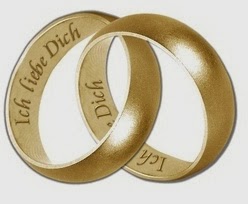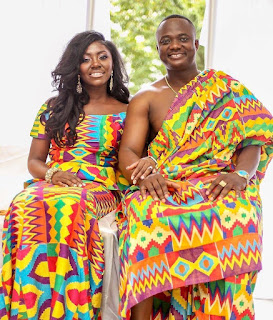Germain weddings
Eheringe (Wedding rings)
During the engagement period both the bride and groom wear a ring on their left hand. After the wedding they wear the wedding ring on their right hand. Usually the rings are gold with no diamonds.
Bräutkleid (Bride's attire)
In Germany, as in the U.S, the bride wears "white". But in Germany brides wear either very short trains or usually none at all attached to their wedding dress. If veils are worn they are of fingertip length and typically never worn over the face as in the U.S. Often in place of veils a flowery headband with ribbons is worn. Other accessories included may be a Diadem (Tiara), a little draw string purse and gloves. The custom is for the bride to dress at her home or her parent's home and then drive to the ceremony.
Bräutigams Kleidung (Groom's attire)
The groom usually wears a black suit or a smoking jacket (dinner jacket)
Die Standesamtliche Trauung (The Wedding)
Before a church wedding the bride and groom will have been married in the Standesamt (Registry Office) by a registrar which is most often in the Rathaus (town hall). A witness is needed for the bride and also for the groom.
Die Kirche-Hochzeit (The Church Wedding)
Together, the bride and groom will enter the church and walk down the aisle. Because it is not legal to have only a church ceremony, the couple will have already been legally married by a Standesbeamte. Unlike in the U.S. it is not customary for there to be bridesmaids, groomsmen or flower girls.
Andere Deutsche Traditionen (Other German traditions)
Brides often carry salt and bread as an omen for good harvests and the groom carries grain for wealth and good fortune.
Before the wedding the bride's possessions are transported to her new home. These may include linens she has collected, a cradle into which a doll has been secretly placed, and for the wedding of a farm girl, her parents second-best cow.
Hochzeitslader
This Bavarian tradition has an official inviter clad in fancy clothes decorated with ribbons and flowers going door to door extending a personal rhyming invitation to the invited guests. Guests accept by pinning one of the ribbons to the Hochzeitslader hat and by offering a drink or two at each stop. Should the invited guests be numerous and the Hochzeitslader be of the nature to accept the offered drinks he may need a day or two to complete his duties!
Junggesellenabschied (Bachelor Party)
Some weeks before the wedding the groom and his male friends go to a Kneipe (pub) to drink and have fun for his last time as a single man.
Polterabend (Wedding Eve)
At a party on the evening before the wedding plates and dishes are smashed to scare off evil spirits. Only china can be used. Anything else would bring bad luck. The bride and groom have to clean up everything. This is to indicate that they can work together.
Hochzeit-Schuhe (Wedding shoes)
Another tradition is for the bride to collect pennies for years to pay for her wedding shoes in which to insure that the marriage "gets off" on the right foot. The bride's mother would place some dill and salt in her daughter's right shoe.
Baumstamm Sägen (Log sawing)
Another old Bavarian tradition occurs right after the church ceremony. When the couple exits the Church there is a log on a sawhorse and the couple has to cut the log in half! This is to symbolize the first tough tasks of their future they can accomplish together.
Fichtenzweige (Fir boughs)
As the couple walks to the wedding car, fir boughs are laid along the path to pave their first newlywed steps with fresh greenery to symbolize hope, luck and fertility.
Reis Werfen (Rice throwing)
In this tradition it is said that the amount of rice that stays in the bride's hair is the number of children the couple will have.
Hochzeitssuppe (Wedding soup)
The Hochzeitssuppe is made from beef, dumplings and vegetables and the guests eat if from a large bowl.
Eine Weisse Band (A white ribbon)
As the guests leave the church the bride gives a white ribbon to each driver of a car in the procession to tie to the radio antenna of the car. This procession then drives through the town honking their horns. Other drivers on the route honk their horns in return to wish the newlyweds good luck in their marriage.
Hochzeitstanz (Wedding dance)
The first dance is danced by the bride and groom and is traditionally a waltz. The next dance is only for the bride with her father and groom with his mother, while the bride's mother dances with the groom's father.













Commentaires
Enregistrer un commentaire